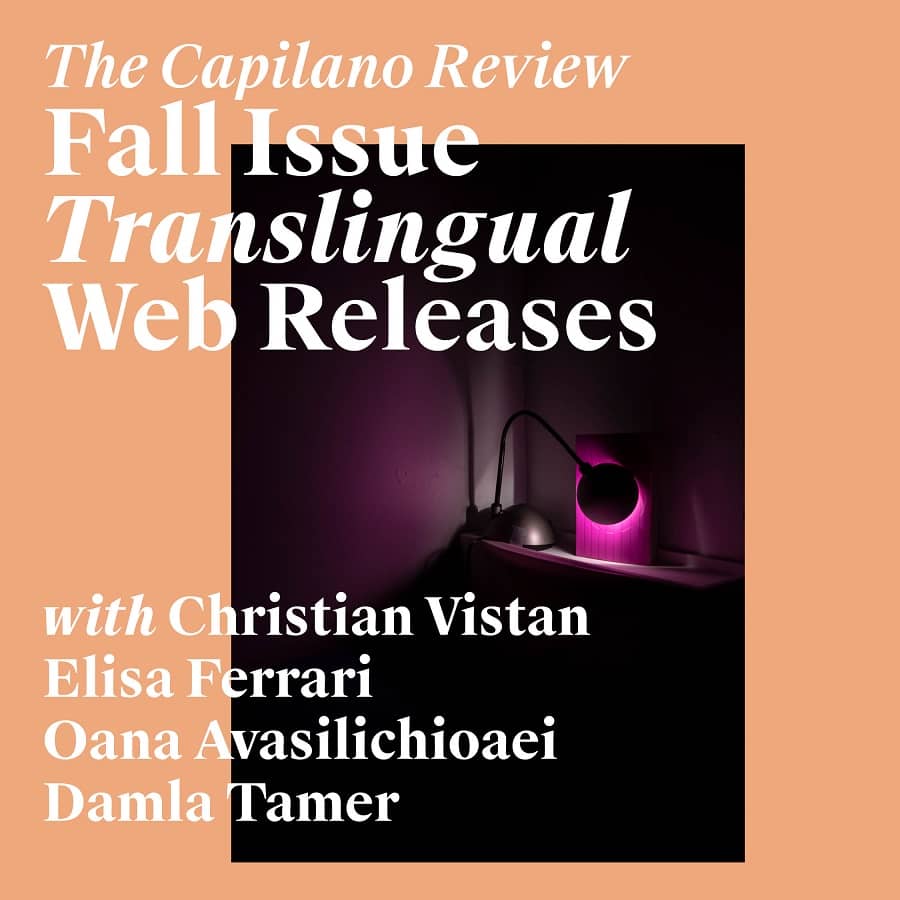
For three weeks beginning Friday, November 20, The Capilano Review celebrates the launch of Issue 3.42: Translingual with three web-only releases. These textual, sonic, and visual activations expand the work in the print issue and feature the work of contributors Christian Vistan, Elisa Ferrari, Oana Avasilichioaei, and Damla Tamer. Links to each digital project will be released through our newsletter and made available to view, listen and read through our website. We invite you to read more about each project below.
Christian Vistan & Elisa Ferrari
SMALL CAPS 5: gaps are eaten up by the reader
Excerpted in Issue 3.42, gaps are eaten up by the reader finds its full form in a SMALL CAPS multi-media publication. Read and listen to Christian Vistan and Elisa Ferrari as they take five walks recorded in July 2020 in their respective neighbourhoods of Ladner and Mount Pleasant on the unceded territories of the Tsawwassen, Musqueam, Squamish, and Tsleil-Waututh First Nations.
Oana Avasilichioaei: Chambersonic
Chambersonic is an ongoing series that translates between voice experimentation, poetic textuality, performative scores, and audio capture / transmission. In Chambersonic (IV), Oana Avasilichioaei uses voice, electronics, portable cassette players, and a contact mic, to translate a portion of the printed score, Chambersonic (I), that appeared in The Capilano Review Issue 3.42.
In Conversation with Cover Artist Damla Tamer
In an interview with TCR‘s Arts Editor Emily Dundas Oke, artist Damla Tamer speaks about the series, Divination Objects, featured in Issue 3.42. The series, which ruminates on the ethics of living and learning, is considered within the larger context of Tamer’s practice, alongside the possibility of scholarly interpretation of image-based divination techniques.
About the Contributors
CHRISTIAN VISTAN is an artist and writer originally from the peninsula now commonly known as Bataan, Philippines. His work has been presented in the Philippines, Canada, and the US. He lives and works on the unceded ancestral territories of the Squamish, Tsleil-Waututh, Musqueam, and Tsawwassen First Nations.
ELISA FERRARI works with text, images, and sound. Her projects become installations, workshops, artist books, and performances. Recently, her work has been presented at the Oscillation Festival (Brussels), Kamias Triennial (Quezon City), Nanaimo Art Gallery, and Western Front. She is currently working on a book of acrostics written with poet Peter Culley under the pseudonym Ana Anani Amiata. She is one of the hosts of Soundscape on Vancouver Co-op Radio, CFRO 100.5FM.
OANA AVASILICHIOAEI interweaves poetry, translation, photography, sound, and performance to explore an expanded idea of language, polyphonic structures, and borders. Her six collections of poetry and poetry hybrids include Eight Track (Talonbooks, 2019) and Limbinal (Talonbooks, 2015). She’s physically based in Montréal and virtually at oanalab.com and soundcloud.com/oanalab.
DAMLA TAMER (born in Istanbul, Turkey) is an artist and educator living on unceded Coast Salish Territories. She works with mark-making, textiles, and spoken performance. Her practice and pedagogy search for a new ethics of temporality through the relationships between safety and vitality. Her work has been the focus of solo exhibitions at Darling Foundry and the fifty fifty arts collective. She is a founding member of A.M. (Art Mamas) artist group, and teaches on a sessional basis at UBC and Emily Carr University.
Issue 3.42 (Fall 2020): Translingual features poetry, compositions, and soundings by Oana Avasilichioaei, Tatum Howey, Dallas Hunt, Klara du Plessis, Amal Rana, Sophie Seita, Sho Sugita, June Tang, and Christian Vistan & Elisa Ferrari; essays by Nicole Raziya Fong and Fan Wu on reading and writing in translingual modes; a conversation between Klara du Plessis and Sophie Seita on the porosity of working adjacent to languages; and Clint Burnham’s interview with artist Mark Igloliorte on the function and form of the kayak. The art in this issue recasts learned narratives and conceptions of time, featuring work by Damla Tamer, Siku Allooloo, Chantal Gibson, and Mark Igloliorte. With reviews by Hagere Selam “shimby” Zegeye-Gebrehiwot on Manuel Axel Strain’s exhibition Needed Medicine, Jessie Loyer on Lindsay Nixon’s nîtisânak, Khashayar Mohammadi on Klara du Plessis’s Hell Light Flesh, and Matea Kulic & Leah Sharzer on Danielle LaFrance’s JUST LIKE I LIKE IT.
Support our free public programming by making a one-time donation or becoming a monthly donor.

